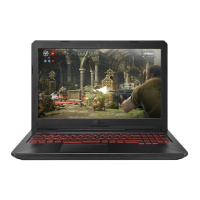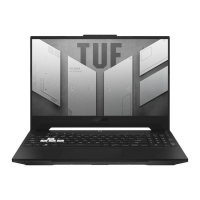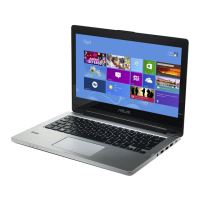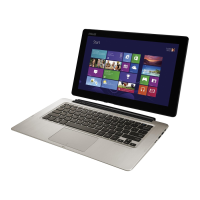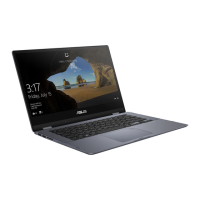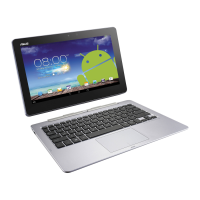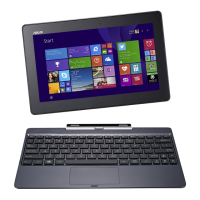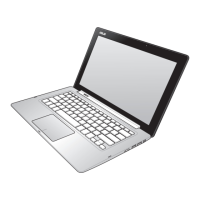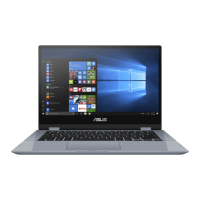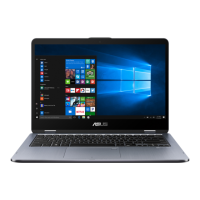Do you have a question about the Asus TUF Gaming A15 and is the answer not in the manual?
Details the components and features visible on the top surface of the notebook.
Explains the function of array microphones for improved voice recognition and recording.
Describes the capability of the built-in microphone for audio recording and conferencing.
Explains the function of the camera indicator light.
Details the built-in camera for taking pictures and recording videos.
Describes the high-definition display panel and its viewing features.
Explains the purpose of air vents for cooling the notebook.
Details the notebook's keyboard features, including QWERTY layout and function keys.
Explains the function of the capital lock indicator.
Describes various status indicators that show the current hardware status of the notebook.
Explains the status of the power indicator light.
Details the meaning of the two-color LED for battery charge status.
Instructions on using the power button to turn the notebook on/off, sleep, or hibernate.
Explains the dual function of the numeric keypad for input and pointer keys.
Describes the touchpad's multi-gesture capabilities for navigation and user experience.
Explains the function of air vents for cooling and heat dissipation.
Describes the cover protecting internal storage and RAM modules.
Explains the function of the built-in audio speakers.
Describes the USB 2.0 port and its compatibility with various devices.
Mentions air vents on the right side for warm air exhaust.
Explains the use of the security slot for physical protection.
Instructions for connecting the power adapter to charge the notebook.
Explains how to connect to a local area network using the LAN port.
Describes the HDMI port for multimedia connectivity.
Details the USB 3.2 Gen 1 port and its transfer rate.
Explains the USB Type-C port for data transfer and display output.
Describes the audio jack for connecting headphones, headsets, and microphones.
Mentions built-in audio speakers.
Instructions for connecting the power adapter and charging the notebook's battery.
Important safety warnings and guidelines for handling and using the notebook's battery.
Instructions on how to open the notebook's display panel safely.
Guidance on how to use the power button for various operations like turning on/off and sleep mode.
Explains how to move the pointer on the screen using touchpad gestures.
Details various single-finger gestures for interacting with the notebook.
Explains how to perform left-click actions on the touchpad.
Explains how to perform right-click actions on the touchpad.
Details various two-finger gestures for scrolling and other functions.
Explains how to scroll content vertically using two fingers.
Explains how to scroll content horizontally using two fingers.
Instructions for zooming out on content using two-finger gestures.
Instructions for zooming in on content using two-finger gestures.
Explains how to drag and drop items using touchpad gestures.
Details three-finger gestures for specific actions like invoking Cortana.
Explains how to switch between apps using three-finger swipes.
Describes how to see an overview of open apps with a three-finger swipe up.
Describes how to show the desktop with a three-finger swipe down.
Details four-finger gestures for actions like invoking the Action Center.
Steps to adjust touchpad settings and preferences through Windows settings.
Explains the commands triggered by the function (Fn) keys on the keyboard.
Explains how to change display modes using Fn keys.
Explains how to enable or disable the touchpad using Fn keys.
Explains how to put the notebook into sleep mode using Fn keys.
Explains how to toggle Airplane mode using Fn keys.
Explains the function of special Windows keys on the keyboard.
Instructions on using the numeric keypad for input and pointer functions.
Step-by-step guide for initial setup and configuration of Windows 10.
Overview of the Start menu as the main gateway to programs, apps, and settings.
Instructions on how to open the Start menu using mouse or keyboard shortcuts.
Guide to launching applications from the Start menu.
Explanation of Windows apps displayed in tiled format on the Start menu.
How to launch, customize, and close Windows apps using the touchpad or keyboard.
Steps to manage apps by moving, resizing, unpinning, or pinning them.
Instructions on how to resize app tiles in the Start menu.
Steps to remove apps from the Start menu.
How to pin applications to the taskbar for quick access.
Steps to add more apps to the Start menu.
How to switch between apps and desktops using the Task view feature.
How to display apps side-by-side for multitasking.
Using drag-and-drop hotspots to snap apps into place.
Detailed steps on how to use the Snap feature with mouse or keyboard.
How to access and use the Action Center for notifications and quick actions.
List of keyboard shortcuts for launching applications and navigating Windows 10.
Steps to connect the notebook to a Wi-Fi network for internet access.
How to use Bluetooth for wireless data transfers with other devices.
Instructions on how to enable and disable Airplane mode for in-flight use.
Steps to configure a dynamic IP or PPPoE network connection.
Steps to configure a static IP network connection.
Explanation of the POST diagnostic tests performed during system startup.
How to access BIOS settings or run troubleshooting options during POST.
Overview of the BIOS (Basic Input and Output System) and its role in system startup.
Methods to enter the BIOS setup utility for system configuration.
Details on configuring BIOS settings and accessing advanced modes.
Description of the EZ Mode interface for basic system information and access to Advanced Mode.
How to set boot option priorities and select boot devices.
How to set administrator and user passwords and control system access.
Step-by-step guide to setting user or administrator passwords.
Instructions on how to remove existing passwords from the BIOS.
How to save configuration changes and exit the BIOS utility.
Guide on downloading and updating the Notebook PC's BIOS.
Steps to access and utilize various system recovery options.
Practical advice for maximizing notebook performance and data security.
Frequently asked questions related to the notebook's hardware components and issues.
Troubleshooting steps for a non-functional battery charge indicator.
Steps to troubleshoot issues with the notebook's touchpad.
Solution for cursor movement issues while typing.
How to switch the numeric keypad mode on the keyboard.
Frequently asked questions about software issues and troubleshooting.
Troubleshooting steps for a notebook that fails to boot up.
Solutions for issues preventing the notebook from waking from sleep mode.
Information about the DVD-ROM drive's capabilities and availability.
Details on DVD region codes and playback restrictions.
Lists countries/regions associated with DVD playback regions.
Information about the Blu-ray ROM drive's capabilities.
Statement on the internal modem's compliance with various standards and regulations.
General information about CTR 21 and its application to terminal equipment.
Statement regarding the equipment's compatibility with different networks.
Defines what constitutes non-voice equipment in relation to regulations.
FCC compliance statement regarding radio frequency interference.
Cautionary statement regarding RF exposure limits and compliance.
ISED compliance statement for radio equipment in Canada.
Safety precautions related to telecommunications equipment and lithium batteries.
Requirements for power cords used with products weighing over 3Kg.
Notice for CATV system installers regarding cable grounding.
Information about copyright protection technology used in the product.
Warning to avoid listening at high volume levels to prevent hearing damage.
Safety cautions regarding the explosion risk of lithium-ion batteries.
Approval details for the notebook's modem according to CTR 21 standard.
ASUS's commitment to environmental regulations throughout the product lifecycle.
Information on chemical substances in products according to REACH regulations.
Statement of compliance with the EU RoHS Directive for hazardous substances.
Information on chemical disclosures for Japan RoHS compliance.
Compliance with India's E-Waste (Management) Rules, 2016 regarding hazardous substances.
Information about the protective coating applied to the device.
ASUS's commitment to environmental responsibility through recycling programs.
Contact information for rechargeable battery recycling in North America.
Compliance notice for Singapore regarding IMDA Standards.
Framework for ecodesign requirements for energy-related products.
Information on EPEAT registered products and environmental assessment.
Warnings regarding battery replacement and disposal.
Declaration of compliance with EU directives for the device.
Warnings regarding device operation in specific frequency bands and antenna gain.
| RAM | Up to 32GB DDR4 3200MHz |
|---|---|
| Weight | 2.3 kg (5.07 lbs) |
| Processor | AMD Ryzen 7 4800H |
| Graphics | NVIDIA GeForce GTX 1660 Ti |
| Display | 15.6-inch, FHD (1920 x 1080), 144Hz |
| Operating System | Windows 10 Home |
| Battery | 90Wh |
| Ports | 1 x HDMI 2.0b, 1 x RJ-45, 1x 3.5mm audio jack |
| Wireless | Wi-Fi 6 (802.11ax), Bluetooth 5.0 |
| Storage | Up to 1TB NVMe SSD |

